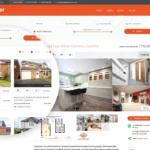
Suppose you’ve been paying attention to the world of digital marketing recently. In that case, you’ll know that one of the most common problems is having website images that are too big or having pictures with the wrong dimensions. Both of these things can be easily fixed by following some simple rules. But do you know why they matter so much? Well, for starters, when your website images are too big, your page loads more slowly than it needs to, which isn’t good for your users and definitely not great for your SEO. Whether you’re a marketer who works on websites regularly or just someone who likes to know about best practices in web design, this article will tell you precisely what you need to know about website image sizes – and fast!
What do image sizes have to do with my website?
The way your images appear on your site – and how big they are – is determined by the code used in your website. When you upload an image to your website, and it looks the way you want it, you’re not actually “seeing” the image itself, you’re actually seeing a code that tells the website to show the image. That code includes information like the image’s width, height, filename, colour, and what your website should do with it when someone views your site. This means that when you upload an image to your website, you have the choice to tell it to keep its original file size or to resize it to a different image size. The image size you choose will determine how it appears on your website.
How does your website know the size of the image?
At its most basic, every image on the internet has what’s known as a “dimensions” attribute. This is just a piece of code that tells the website to show that image with those specific dimensions. The thing is, the website doesn’t know what the dimensions of the image are. It just knows that it’s been told to show a particular image at a specific size. What happens next is up to the browser. The browser takes the dimensions the website has been given and uses those to determine the actual size of the image.
Why are Website Image Sizes and Ratios Important?
Choosing the right picture is imperative for a successful website design. We can’t just toss any old photo on a website and expect it to look good. We must consider the impact of aspect ratio and picture size. Is there a time when a full-width photo is appropriate? Do aspect ratio and size matter? It’s not often that an image must be the whole width of a page, whether it’s a key image on a blog post or an ‘About’ page. You can use a full-width image for your website’s header to create an overarching statement that pulls the website together. It should be wide but not too tall – there’s little point in the header taking up the entire screen unless the design of the site requires it. There’s little merit in forcing readers to scroll down for minutes before they can see anything else unless the point is to keep them at the top.
The Importance of Website Image Dimensions for SEO
If you’re someone who understands SEO, you probably already know that image sizes are very important for SEO. But even if you work in another part of online marketing or a completely different industry, you probably have a sense that image sizes are important. To put it simply, there are only so many pixels that can fit on your website. If you have big website images and lots of them and they are poorly compressed, they’re probably taking up a lot of space and not allowing your content to show up correctly. That’s not good for SEO. You definitely want your content to be seen by search engines, but you also want your website to load as quickly as possible. There’s not much point in your content being there if it’s delayed behind a poorly compressed image download. And if you only have one image on your page, and it’s too large, it can be the same thing. If your image is too big, the browser is forced to shrink it down to the size that it’s supposed to be, but that takes time. And when your page takes longer to load than it should, you’re going to lose potential visitors.
The Importance of Website Image Dimensions for User Experience
The last thing you want to do is annoy your visitors with a slow-loading website – or a bunch of images that you can’t even see! To put it simply, the better your images look, the better your website looks. And the better your website looks, the more likely it is that people are going to stay on it and that they’re going to share it with their colleagues, friends and family. That doesn’t mean that you should sacrifice great content for beautiful images on your website. But it does mean that if you’re not careful, you’re going to end up with images that are too big, and your images are going to ruin your website experience for your visitors. You don’t want your images to load your website too slowly. You don’t want them to make your pages so big that they’re too full to even see your content. And you definitely don’t want to have to scroll through endless images just to read one piece.
Steps to Find Out If You Have Image Sizes Too Big on Your Website
We’ve covered many reasons why having website images that are too big is a problem. So now the question is, how do you know if you have images that are too large? You’ll start by getting a list of all the images that you’re currently using on your website. You can do this two ways: You can either go through your website manually and check each image one-by-one, or you can use software like Google Analytics to see which images are being used the most on your site. Once you have a list of the images on your site, you can check which ones seem overly large in terms of download size.
What If My Website Images are Too Big?
If you’re worried that your website images are too big, don’t worry. You can easily fix this problem. This is especially true if you uploaded your images without any sort of “managing”, which is the industry term for resizing the image. If you uploaded the images without managing them, you probably just uploaded them as big as they were. You might have even uploaded them as the original image file, which can be up to 1,000 times bigger than they need to be. If your images are too big, your best option is to get in touch with the person who made them and ask them to make them smaller and compress them using the most appropriate file format based on image content. If you made the images yourself, then you need to make sure that you properly manage them before you upload them to your site.
There are lots of free web tools out there to compress your website images. We use TinyJPG often to compress WebP, JPEG and PNG images.
Conclusion
When your website loads, it has to take the code for your images, interpret that code, and translate that code into an image for people to see. If the images are too big, then the website has to work a lot harder. It takes longer to load, and it uses more bandwidth than it should. The good news is that image sizes are something that you can easily fix. All you have to do is let your designer or photographer know what the dimensions need to be, and they can make the changes. Now you know everything you need to know about website image sizes. You understand what they are, what they do, and how you can fix them if you need to. For marketers, images are a great way to engage customers and tell a story. They are important to have the right image sizes, especially on social media. You want to engage your customers and make them want to see more.
Book a No-Obligation 30 minutes call with our web design experts
Our 30 minute “getting-to-know-you” phone call is designed to see if your project is something we are able to help with. Be prepared to discuss your business fundamentals, your hopes & expectations of your project and your current business challenges. Schedule a call now.




